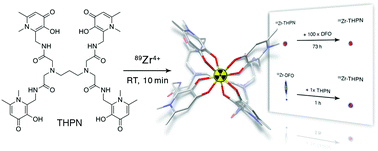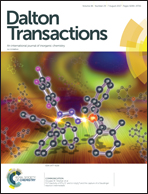A new tetrapodal 3-hydroxy-4-pyridinone ligand for complexation of 89zirconium for positron emission tomography (PET) imaging†
Abstract
Zirconium-89 (89Zr) is an ideal radiometal isotope for antibody-based positron emission tomography (immunoPET) as its physical half-life (3.27 days) is a good match with the biological half-life of larger molecular weight targeting molecules, such as antibodies (3–4 days), and its positron emission (BR = 100% EC/β+, Eβ+,avg = 395.5 keV) is suited for high resolution PET imaging. Concerns over the in vivo stability of the most commonly used 89Zr-chelator, desferrioxamine B (DFO), have spurred efforts into the development of alternative 89Zr-chelators that withstand the release of osteophilic 89Zr4+. Herein we report the new chelator 1,3-propanediamine-N,N,N′,N′-tetrakis[(2-(aminomethyl)-3-hydroxy-1,6-dimethyl-4(1H)-pyridinone)acetamide] (THPN) based on four 3-hydroxy-4-pyridinone (3,4-HOPO) coordinating groups, as a potentially superior chelator over DFO. THPN has been demonstrated to quantitatively form a monometallic complex with Zr4+ within 10 min at ambient temperature at as low as 10−6 M concentrations of the chelator. The resulting complexes were studied in vitro and in vivo. The 89Zr-THPN complex was stable in serum and outperformed the 89Zr-DFO complex in a direct transchelation challenge. Healthy mice excreted 89Zr-THPN rapidly without signs of demetalation or residual organ uptake. This renders THPN as a promising alternative to DFO and introduces the first octadentate 3,4-HOPO chelator to the field.



 Please wait while we load your content...
Please wait while we load your content...